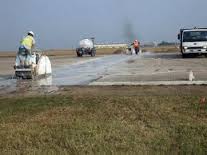 After 30 years, a runway begins to show its age.
After 30 years, a runway begins to show its age.
Repeated landings of 150,000-pound aircraft at Tulsa International Airport’s 10,000-foot main north-south runway have taken a toll on the pavement, airport executives said.
Last reconstructed in 1982, the main runway is undergoing a $19.9 million rehabilitation involving 7,000 feet of pavement. Two earlier phases of the runway reconstruction rebuilt 1,200 feet at the north and south ends of the runway.
The contractor, Interstate Highway Construction Inc. of Englewood, Colo., is scheduled to complete the runway work by May 15, barring weather delays.
The work includes pulverizing and hauling away the 18-inch-thick concrete and laying down 60,000 cubic yards of new concrete over an 18-inch-thick cement-treated rock base.
The runway reconstruction could not be postponed any longer, said Airports Director Jeff Mulder.
“The pavement is breaking up, creating FOD, which is bad for (aircraft) engines,” he said.
FOD is an acronym for foreign object debris or foreign object damage.
FOD is any object that does not belong in or near airplanes and, as a result, can damage airplanes or injure airport or airline workers, says the Federal Aviation Administration and Boeing Co., the airplane manufacturer.
FOD incidents cost the aerospace industry $4 billion a year, Boeing says.
FOD includes rocks, pavement fragments, hardware, catering supplies, building materials, sand, pieces of luggage and wildlife.
“FOD is found at terminal gates, cargo aprons, taxiways, runways and run-up pads,” Boeing says in a briefing paper “Foreign Object Debris and Damage Prevention.”
“It causes damage through direct contact with airplanes, such as by cutting airplane tires or being ingested into engines, or as a result of being thrown by jet blast and damaging airplanes or injuring people.”
The most famous incident involving FOD in recent years was the collision in New York City between a flock of migrating Canadian geese and US Airways Flight 1549 on Jan. 15, 2009.
The ingestion of the geese shut down both engines of the US Airways plane at 3,200 feet just after takeoff from LaGuardia Airport.
Without power, the Airbus A320 was reduced to a glider.
Fortunately, Capt. Chesley Sullenberger III was a veteran glider pilot and expert glider flight instructor.
Sullenberger guided the plane to a landing in the Hudson River between New York and New Jersey and all 150 passengers and crew were evacuated safely, news reports said.
But the bird strike in New York isn’t an isolated FOD incident, government and industry officials said.



